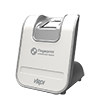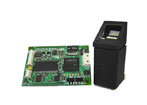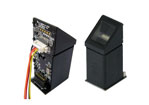What are fingerprint sensors?
Identity Identification of fingerprints is one of the oldest recognition of identity methods. For a long time ago, fingerprints have only been used to identify criminals. A fingerprint is an irrefutable method in identifying. Biometric methods can provide security for financial transactions and individuals' private information. This method is used widely in governments, the army, and organizations. The identification of people with the help of physiological data is called biometric. Since biometric information is always available, it is more efficient than other methods of authentication that may be forgotten, stolen, or lost. The security of fingerprint identification systems is always considered due to being deceived and invaded by fraudulent fingerprints.
One way to combating fake fingerprint is recognition being alive of fingerprint tissue. The main reason for selecting fingerprint sensors to identify people is that the fingerprints of each person are unique, and some of these features remain constant until the end of their lives. The same components are used in matching fingerprints. Fingerprint identification is based on the analysis of receiving data. Therefore, the functionality and efficiency of the fingerprint identification system depend on the accuracy of the data extracted.
Humans have unique features such as abrasion fingerprints or small crossover lines across the palms of the hands and feet. These prominence and lines are formed in the palm of your hand when we are in the mother's womb. So no one in the world has the same fingerprints. The tip of the finger has a series of lines that extend from one side to the other side. Since the identification process involves receiving the fingerprint image and matching it with the information stored in the database, so in regarding the occurrence of events such as wounds, burns, noise, and poor quality of image, it has to be repaired and improved on the image.
Types of fingerprint sensors:
Optical fingerprint sensors:
Optical sensors are the oldest type of fingerprint sensor; it records your fingerprints as a camera. This method is based on that the sensor recognizes unique fingerprint patterns by recording a fingerprint image and using special algorithms. The sensors have a large number of diodes per inch so that they can receive information with great care. When you put your finger on the sensor, space will be very dark, and it's impossible to record accurately image. A LED row is used as a flash to provide a suitable environment for shooting. Of course, this technology is not suited for the design of smartphones because it is bulky, and builders like a product are thinner than the past. Problems in using an optical fingerprint scanner:
- It only has a 2D print and hence less secure.
- Very bulky and hence not suitable for smartphones
Capacitive fingerprint sensors:
These sensors are composed of a set of capacitors the position of the finger on the sensor and change the capacitance and changes, completely store fingerprint image. Problems in using capacitive scanners:
- It depends on the conductivity of your finger & hence requires a clean finger (Dirt or water may create false positive).
- Doesn't work on opaque Objects (works only with OLED screens & not IPS).
Ultrasonic fingerprint sensors:
The ultrasonic sensor works by using ultrasonic waves. In this way, the ultrasonic waves, embedded below the sensor, sent by the transmitter, and according to the depressions on the fingers per user, some of the radiation is absorbed as well as some will return to the sensor. Advantages of using ultrasonic sensors:
- The proper function even if the user's finger is wet.
- They can use even under layers of thin plastic. In capacitive sensors, if sensors are dirty or sweaty, fingers may not work correctly; however, ultrasonic sensors will not face such problems.
Thermal sensors:
Thermal sensors calculate the amount of heat energy or even coldness produced by an object or device so that any actual shift in the temperature can be "sensed" or detected, creating either an analog or a digital output.
Fingerprint sensors remain one of the most reliable and widely adopted biometric technologies today. With advancements in artificial intelligence, sensor hardware, and cybersecurity, the fingerprint recognition landscape has evolved significantly. This article explores modern developments, real-world applications, AI integration, and market insights to provide a complete 2025 update on fingerprint sensor technology.
Today, many modern IoT applications rely on fingerprint sensors to quickly identify users for added safety and security. Fingerprint sensors spread out in many fields, particularly smartphones, wearable gadgets, industry, and smart homes for entry identification and data protection.
Evolution of Fingerprint Sensor Technologies
Fingerprint sensors remain one of the most reliable and widely adopted biometric technologies today. With advancements in artificial intelligence, sensor hardware, and cybersecurity, the fingerprint recognition landscape has evolved significantly. This article explores modern developments, real-world applications, AI integration, and market insights to provide a complete 2025 update on fingerprint sensor technology.
Ultrasonic Sensors
Unlike traditional optical and capacitive sensors, ultrasonic fingerprint sensors use high-frequency sound waves to map the ridges and valleys of a fingerprint in 3D. This not only enhances accuracy but also allows for secure recognition even when the finger is dirty, wet, or oily. These sensors are more resistant to spoofing and are increasingly found in flagship smartphones and high-security access systems.
Under-Display Sensors
The rise of bezel-less smartphone displays has driven demand for under-display fingerprint sensors. These sensors can be embedded beneath OLED screens, enabling authentication without visible hardware. This technology is commonly used in devices from Samsung, OnePlus, and Xiaomi, offering both aesthetics and functionality.
Flexible and Transparent Sensors
Emerging research has produced flexible and transparent fingerprint sensors using materials like graphene and organic polymers. These allow for innovative integration into wearables, flexible displays, and curved surfaces — paving the way for next-generation consumer electronics.
Integration with Artificial Intelligence and Machine Learning
AI-powered fingerprint recognition systems offer faster processing and improved accuracy through intelligent pattern recognition. Machine learning algorithms can adapt to variations in finger placement, partial prints, and even biometric changes over time due to aging or injuries.
Moreover, AI enables:
- Dynamic Learning: Systems that adapt to subtle changes in user fingerprints.
- Fraud Detection: Identifying anomalies that may indicate spoofing or unauthorized access.
- Context-Aware Access: Systems that factor in location, behavior, or usage patterns to enhance decision-making.
Diverse Applications Across Industries
Automotive Sector
Biometric ignition systems allow users to start a vehicle using only their fingerprint. In addition to access control, these systems can activate personalized settings such as seat position, climate control, and infotainment preferences.
Healthcare and Hospitals
Fingerprint authentication helps protect sensitive medical records, control access to medication storage, and prevent identity fraud in patient management systems. It reduces dependency on passwords and badges that can be lost or stolen.
Banking and Financial Services
Biometric payments are gaining traction in both online and physical banking. ATMs with fingerprint readers eliminate the need for cards, while mobile banking apps use biometrics to authenticate transactions.
Smart Homes and IoT
Fingerprint sensors are now integrated into smart door locks, safes, and home automation systems, offering convenient and secure user control.
Enhanced Security Through Liveness Detection
To counter spoofing attacks using fake fingers or lifted prints, modern fingerprint sensors incorporate liveness detection. Techniques include:
- Capacitive Sensing: Detecting the electrical conductivity of human skin.
- Optical Variability Analysis: Identifying blood flow or micro-movements in live tissue.
- Ultrasound Pulse Feedback: Measuring skin texture beneath the surface.
These methods help ensure that only a live human can trigger authentication, enhancing security in sensitive environments.
Market Growth and Future Trends
The global fingerprint sensor market is projected to reach over $6.96 billion by 2032, driven by increasing adoption in smartphones, government ID programs, healthcare, and industrial security. Asia-Pacific remains the largest and fastest-growing region due to its large population and widespread use of mobile technology.
Key trends include:
- Biometric Multimodal Systems: Combining fingerprint with facial or iris recognition.
- Edge AI Integration: Processing biometric data directly on devices, reducing latency and protecting privacy.
- Sustainable Materials: Developing eco-friendly sensors that minimize environmental impact.
Conclusion
Fingerprint sensors are evolving rapidly to meet the demands of modern security, convenience, and design. From ultrasonic scanning and AI-powered recognition to industry-specific applications and enhanced spoof protection, this technology continues to shape how individuals and organizations secure their digital and physical assets. As we look toward the future, fingerprint sensors will play a crucial role in enabling safer, smarter, and more personalized experiences across the globe.









































































